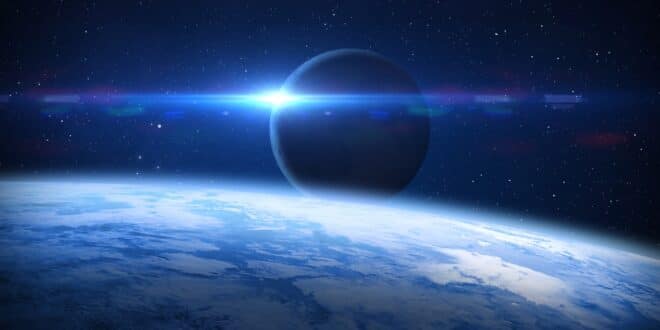For centuries theories have circulated regarding the origins of life as we know it. Many suggest that the forms of life we see and are part of slowly evolved over millions and even billions of years. There is no definitive way to prove any one theory. In fact, the website LiveScience, says, “Science remains undecided and conflicted as to the exact origin of life, also known as abiogenesis. Even the very definition of life is contested and rewritten, with one study published in the Journal of Biomolecular Structure and Dynamic, suggesting uncovering 123 different published definitions.”
The Genesis story of creation is not a theory, but rather a statement of faith that depicts how our planet and its life forms came into existence. We choose to believe this and celebrate the God who brought it to pass. –Answers For Me Editorial Staff
Although science still seems unsure, here are some of the many different scientific theories on the origin of life on Earth.
1. What was created on the first day of creation week?
God said, “Let there be light.” (Genesis 1:3). The Earth had previously been dark (Genesis 1:2). On the first day, God caused Earth to be lighted. This does not mean that light had not existed prior to this time, because God’s presence is associated with light (Revelation 22:5). It is not necessary to suppose that the physical phenomenon of light was first created at that time, but the previously dark Earth was lightened. One possible explanation of the light is that God personally and physically came to Earth, causing it to be lightened. If so, then how could it become dark (evening) again? Perhaps the rotation of Earth produced day and night in different portions of Earth, as it does today.
Another possible explanation of the light is that the sun and solar system actually existed before creation week, but the light was obscured so that Earth’s surface was dark. Earth at that time might be compared with Venus, where the thick atmosphere obscures the sun’s light. On the first day, the atmosphere was cleared sufficiently to permit light to reach the Earth’s surface.1
Perhaps light was produced from another source, such as a supernova.
2. What was created on the fourth day of creation week?
God said “Let there be lights in the firmament of the heavens to separate the day from the night….” Two great lights are described, one to rule the day and one to rule the night. These lights appeared on the fourth day of creation week. The details are not given. They may have been created on that day. If so, the light of the first three days might have been provided by God’s presence.
If our solar system existed before the creation week, as some creationists think is probable, then apparently the sun itself was not visible until the fourth day. This might be explained as due to atmospheric cloud cover, permitting diffuse light to reach the surface, but not revealing the source of that light. On the fourth day, perhaps the atmosphere was cleared to permit the sun and moon to be seen for the first time.
Another possible interpretation is that the sun and moon existed prior to that time, but on the fourth day they were “appointed” to specific functions relative to the Earth.
The phrase, “he made the stars also” does not require that God created the stars ex nihilo on the fourth day of creation. Some creationists have held that the entire universe, or at least the visible portion, was created on the fourth day. The text permits this reading, but does not require it. “The stars also” is merely a parenthetical phrase in which God is identified as the creator of the stars without identifying when this was accomplished. The text appears to permit the interpretation that the stars were already in existence, perhaps with planets inhabited by other created intelligences.2
3. Why doesn’t the sequence of the days of creation match the sequence in the fossil record?
The sequence of creation according to Genesis included the following: 1) land plants, including fruit-bearing trees; 2) flying creatures (such as birds) and swimming creatures (such as fish and whales); 3) land creatures (such as reptiles, mammals and humans). In the fossil record, the sequence is rearranged to: 1) fish; 2) land reptiles; 3) flying reptiles; 4) land mammals; 5) birds; 6) fruit-bearing trees; 7) whales; 8) humans. The fossil sequence does not match the creation sequence, because the fossil record is a record of death rather than a record of the creation of life. The fossil record was produced after the creation week. There was no process of fossilization between the days of creation.
4. Could the days of creation actually represent periods of a thousand years each, as suggested in 2 Peter 3:8?
Making the creation “days” equal to a thousand years each does not help explain the text. The fossil sequence does not match the creation sequence. Vegetation is created before marine creatures, but appears after it in the fossil record. Birds are created before reptiles, but appear after them in the fossil record.
If the thousand years are thought of as having a single evening and morning, each evening must have occupied approximately half of that time, or 500 years. Vegetation could not survive 500 years of darkness. If the thousand years are thought of as ordinary years, this does not resolve the supposed ages of the fossils, which are thought to be millions of years old. Any attempt to make the creation “days” equal to a thousand years accomplishes nothing to resolve the scientific questions.3
5. Could the “days” of creation represent indefinite periods of time?
In Genesis, the “days” are numbered from 1 to 7, indicating a sequence. They consist of “an evening and a morning”—a dark period and a light period. The process of creation that is described is fiat—creation on command. The language seems clearly to indicate ordinary days.4
One test of whether this interpretation is correct is to determine whether the “days” are used to make any point in the rest of Scripture. They are. In Exodus 20:11 and 31:17, the days of creation are used as the basis for observance of the seventh-day Sabbath. The interpretation of creation days as literal days is supported by the occurrence of the Sabbath as one literal day out of the week of seven literal days.
Interpreting the creation “days” as seven indefinite periods of time does not seem helpful. The sequence of events in Genesis does not match the geologic record. If the days are not literal, the sequence of events surely is not literal, and the process of instantaneous creation by fiat is not literal. If Genesis does not accurately describe the sequence of events or the process involved, it seems pointless to attempt to find significance in the seven time periods.
6. Did the creation take place 6000 years ago?
The Bible does not give a date for the creation. It does contain chronological and genealogical data that suggest a creation about 6000-7500 years ago, depending on which of the ancient versions is used. Some creationists have concluded that the biblical chronological data is essentially complete, and the creation occurred about 6000 years ago. Other creationists who are unconvinced that the biblical data is complete would accept an extension of time, so long as it did not change the character of the creation story. Moving the creation and flood back a few thousand years would make little theological difference, but moving it back into the millions of years would imply that humans have improved over time, which is contrary to the message of the Bible. Therefore, most biblical creationists would insist that the age of the Genesis creation is measured in thousands, but not millions, of years.
7. How did Cain find a wife if there were no other humans around before creation week?
Adam and Eve had many children, of both sexes (Genesis 5:4). Daughters’ names are infrequently mentioned in Scripture, but they were present. Cain undoubtedly married a sister. This would have presented no genetic problems among people so recently created. Accumulations of harmful mutations since that time have made it highly inadvisable for siblings to produce children, because of the greatly increased probability of genetically defective offspring. Abraham apparently married a half-sister (Genesis 20:12), which suggests that within-family marriages were socially acceptable during the time of Abraham.
8. Why do Genesis 1 and 2 present different accounts of the creation?
Some feel the two accounts are contradictory, while others maintain that the two accounts are complementary. The complementary interpretation might suggest that the creation week is outlined in Genesis 1, ending in Genesis 2:4. Genesis 1 is concerned with the chronology of creation, while Genesis 2 is an amplification of the creation of humans and their Eden home. Genesis 1 introduces the universality of the creation, while Genesis 2 provides the opening for the stories of human experience told in the remainder of the book. The language of the two chapters can be interpreted as conflicting if one chooses to do so, but the language does not require a conflict.5
9. What unsolved problems about creation week are of greatest concern?
What events took place on Days 1 and 4 of Creation Week? When were the water and minerals of the Earth created?
If you liked this, you may also like Before Creation | Geoscience Research Institute
Published with permission.
Endnotes for Questions about Creation Week:
© 2002 - 2025, AnswersForMe.org. All rights reserved. Click here for content usage information.
 Answers for Me Support & encouragement for every-day life
Answers for Me Support & encouragement for every-day life



